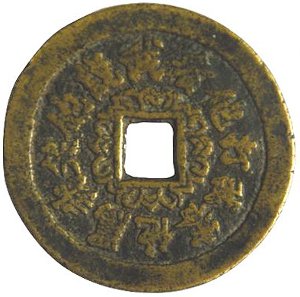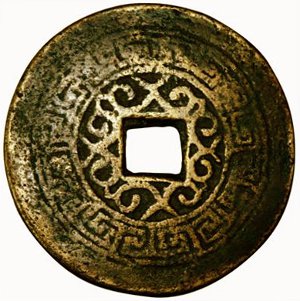A palindrome is a word or phrase that reads the same forward or backwards. For example, “rats live on no evil star” is the same whether you read it left to right or right to left.
Creating palindromes is actually much easier in Chinese, which uses “characters”, than in English which uses an alphabet. If fact, every Chinese “word” (character) is itself a palindrome because it has exactly the same pronunciation and meaning whether read left to right or vice versa.
China has had a literary genre known as “palindromic poetry” (hui wen shi 回文诗) since ancient times. The genre is not strictly palindromic, however, because the meaning does not have to be exactly the same when reading forward or backward. What is important is that the phrase or sentence must make sense in both directions.
Chinese charms with palindromic inscriptions are very rare and often not even documented in numismatic references and catalogs.

Chinese 12 Character Palindrome Charm
The Chinese charm at the left is one of these rare examples with a palindromic inscription.
The inscription consists of 12 Chinese characters inscribed around the rim which reads “我笑他说我看他打我容他骂.
The most basic translation is “I, laugh, he, talks, I, look, he, hits, I, am tolerant, he, scolds”.
However, the meaning of a verb may change depending on whether it precedes or follows the pronoun.
Since this is a palindrome, you can begin with any pronoun or verb and read clockwise or counterclockwise.
As an example, starting with the “second” character in the inscription written above, the meaning would be “laugh at him scolding me (笑他说我)”, “look at him fight me (看他打我)”, “be tolerant of him cursing me (容他骂我)”.
Reading the same characters counter-clockwise would be “I curse and he is tolerant (我骂他容)”, “I fight and he watches (我打他看)”, “I speak and he laughs (我说他笑)”.
Therefore, completely different meanings occur depending on which pronoun or verb you begin with and which direction you are reading.
The charm provides us with a glimpse into the daily life of two people, namely “I” and “he (or she)”. The two people could be husband and wife, two lovers, two friends, two co-workers, a boss and employee, two family members, etc. The various permutations of dialogue express a range of attitudes people in a relationship may find themselves in including love, admiration, understanding, tolerance, and even not caring.

The reverse side of the charm has a “cloud and thunder” pattern similar to the design found on ancient Chinese bronzes.
Based on the calligraphy, design, metal, and casting, this charm is believed to have been made during the Qing Dynasty (1644-1911) by one of the ethnic minority groups in southern China.
The charm is made of brass and has a diameter of 51.64 mm and a weight of 35.05 grams.
Another example of this palindromic charm is known to exist. However, it is slightly smaller with a diameter of 44 mm.